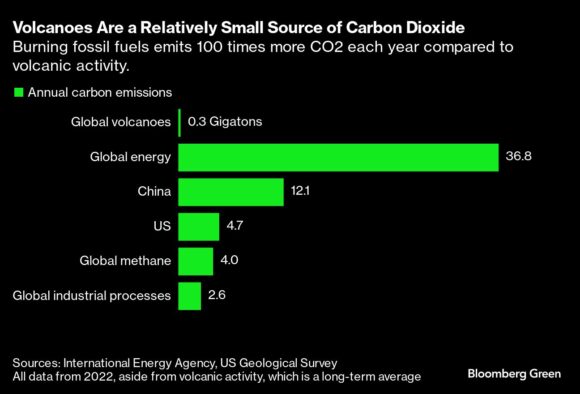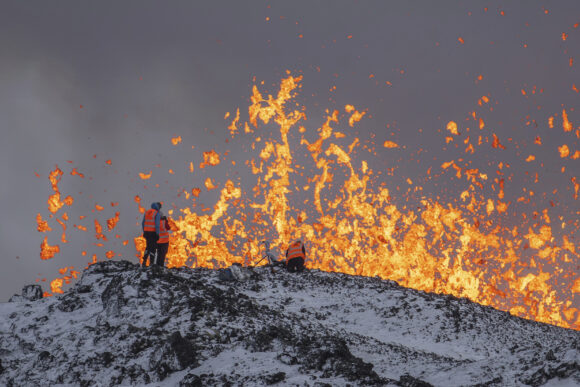A volcanic eruption on Iceland’s Reykjanes Peninsula sent lava flowing through a 4-kilometer (2.5-mile) crack in the Earth’s crust.
The eruption began in earnest on Monday and occurred near the evacuated fishing town of Grindavík, with lava shooting into the sky as high as 100 meters (330 feet).
While volcanic eruptions can help temporarily cool the planet, this one isn’t likely to provide any type of significant climate impact, despite the dramatic videos and images.
Eruptions typically have a cooling effect when they eject ash and other compounds, including sulfur dioxide, into the atmosphere. Once aloft, sulfur dioxide interacts with water to form what are known as aerosols, which are tiny particles that act like a mirror, reflecting incoming solar radiation back into space. This means that less heat reaches the Earth. Adding extra sulfur dioxide to the atmosphere can also enhance cloud formation in certain cases, which further reflects solar radiation away from the planet. When volcanoes put enough aerosols in the atmosphere, the cooling effect can last several years and span an entire hemisphere.
An example of this phenomenon was on display in 1991 when Mount Pinatubo erupted. The volcano sent about 15 million tons of sulfur dioxide into the atmosphere. In response, the global average temperature dropped 0.6C (1.1F).
In the case of the Icelandic eruption, however, a large ash cloud is unlikely. This is in part because the magma burbled out of the Earth on land, which can generate less explosive ash plumes than when lava interacts with water. In 2010, lava from Volcano Eyjafjallajökull in the south of Iceland made contact with ice on the mountain’s flanks, creating a massive cloud of ash that grounded European air travel for weeks.
The chemical composition of the magma coming up from the Earth also makes it unlikely to result in major ash clouds, according to Jonathan Fink, professor of geology at Portland State University.
“It’s a particular kind of magma — basalt,” he said. “Those eruptions don’t tend to eject as much material high up where they can reflect sunlight.”
Volcanic eruptions can sometimes also have a warming effect on the planet by releasing greenhouse gases into the atmosphere. But that’s generally far outweighed by the amount humans emit, according to Drew Shindell, a professor of Earth sciences at Duke University’s Nicholas School of the Environment.

The relatively small size of the eruption, and thus low emissions of greenhouse gases, means that there’s likely to be no warming, Fink said.
And with the Icelandic eruption unlikely to produce enough aerosols to have a meaningful impact on the Earth’s temperature either, the world won’t get a reprieve from global warming. In addition to climate change fueled by greenhouse gases, El Niño — another natural phenomenon — is much more likely to increase temperatures in the coming year.
Photograph: Scientist of the University of Iceland take measurements and samples standing on the ridge in front of the active part of the eruptive fissure of an active volcano in Grindavik on Iceland’s Reykjanes Peninsula, Tuesday, Dec. 19, 2023. (AP Photo/Marco Di Marco)
Was this article valuable?
Here are more articles you may enjoy.



 Wall Street Pushes Back After Activists Escalate Protests
Wall Street Pushes Back After Activists Escalate Protests  What Happened to Reinsurance ‘Class of 2023’? Hard Market Defies Age-Old Patterns.
What Happened to Reinsurance ‘Class of 2023’? Hard Market Defies Age-Old Patterns.  Beryl’s Remnants Spawned 4 Indiana Tornadoes, Including an EF-3: NWS
Beryl’s Remnants Spawned 4 Indiana Tornadoes, Including an EF-3: NWS  Elon Musk Beats $500 Million Severance Lawsuit by Fired Twitter Workers
Elon Musk Beats $500 Million Severance Lawsuit by Fired Twitter Workers 

